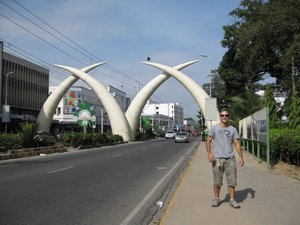Advertisement
Published: February 22nd 2010

 Gateway to Kenya
Gateway to Kenya
These were built in honour of a visit from the British royal family many years ago. We planned to spend a couple of weeks touring along the northern coast of Kenya, making the most of what was left of the warm summer weather before the seasons were due to change. First stop was Mobassa, a full days bus ride south east from Nairobi.
The striking thing about Mobassa is it’s apparent lack of Swahili culture. Don’t get me wrong, it’s certainly there, but just hidden beneath a more prominent hindu surface. One could be mistaken for thinking they had landed in Bombay or any other Indian city as the influence is quite pronounced. Having spent time in Nairobi in a relatively nice part of town the difference was immediate. The streets were less developed, there were many mosques around and even the appearance of the locals seemed to be a real mix with more Indian heritage.
Coming into town you pass an endless queue of lorries and trucks backed up waiting to leave with all of their goods loaded up. I must have counted at least 50 semi trailers loaded up ready to take all of the goods received through Kenya’s main port to the rest of the country. The amazing thing about all of
this is the roads between Nairobi and Mombassa are terrible. Some stretches have been fully resurfaced and are quite good but there are a surprisingly large number of areas which are gravel and dirt, some with major pot holes and you wonder how on earth a country can have it’s major cargo route in such a poor state.
In the past few weeks we’ve learned that previous governments had once received large sums of international aid to fix the road infrastructure but that it had vanished into a big black tarmac filled hole without so much as even improving any of the major highways. There appears to be a lot of work going on now though, all contracted through major international companies, particularly Chinese companies which is ensuring that the work gets done.
Being the major port town, Mombassa is somewhat of a melting pot as its long standing history of international trade stretches as far as India, Italy and China. It’s main attraction is the interesting Fort Jesus which is made of one meter thick coral and has a long distinguished history of forever changing hands of power. Built in 1953 by the Portuguese it has interesting

 Fort Jesus
Fort Jesus
This fort has meter thick walla made of coralarchitecture however there doesn’t appear to be much money around for preservation so its unlikely to last as well as one might hope.
We didn’t spend much time in Mombassa as it was really just a stopping point whilst passing through. There were some interesting spice markets where we tried a few new foods such as red bananas and one thing which we thought was a baby watermelon but turned out to be a cucumber. The old town was also worth the visit with it’s windy old streets which one can easily get lost in. The best thing I would have to say was our curry lunch which was a delicious fragrant spicy feast, all for less than £3 for the two of us.
One of my fondest memories of Mombassa is when we first arrived. I noticed the kids running around playing freely with not a care in the world. There’s obviously a network of safety with the local community with the adults who sit by the street side knowing all the kids and there’s not yet the fears of kidnapping or other horrible things that have become common fears in the western world. We watched with

 Inside fort jesus
Inside fort jesus
You can see the portuguese influence in designjoy as a group of about ten kids ran riot in the streets each running a tyre along trying to race it to the unknown finish line somewhere a few streets away. One poor kid had a pretty large car tyre so he was up the back with the poor kids who didn’t have any tyres. I think it was safe to say the one with the bicycle tyre was likely to win but who knows, they were gone in no time!
Advertisement
Tot: 0.551s; Tpl: 0.01s; cc: 5; qc: 47; dbt: 0.0423s; 1; m:domysql w:travelblog (10.17.0.13); sld: 1;
; mem: 1.2mb

 Gateway to Kenya
Gateway to Kenya
 Fort Jesus
Fort Jesus
 Inside fort jesus
Inside fort jesus




